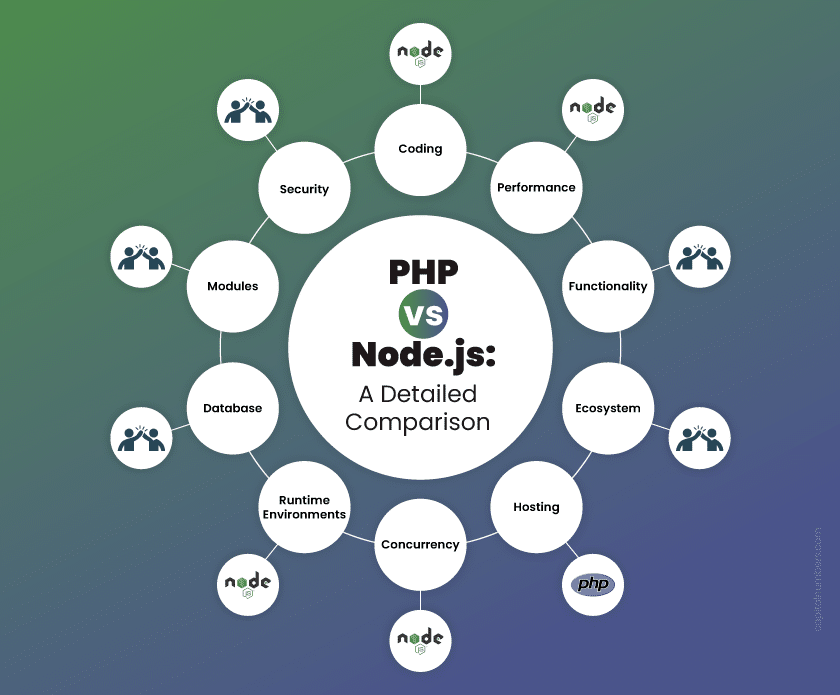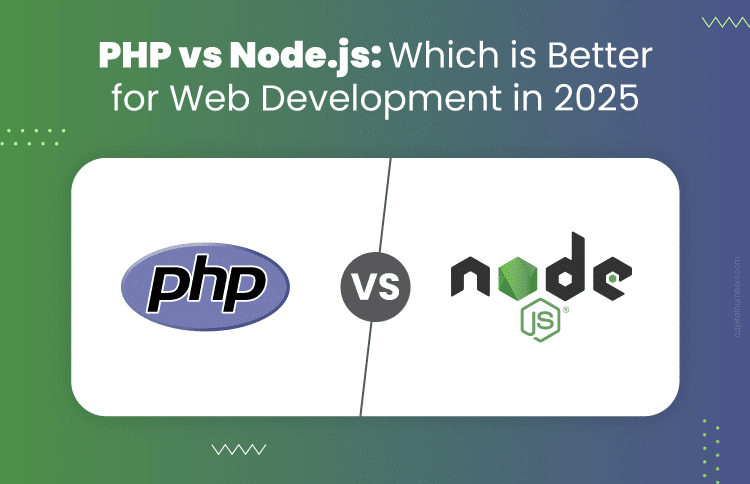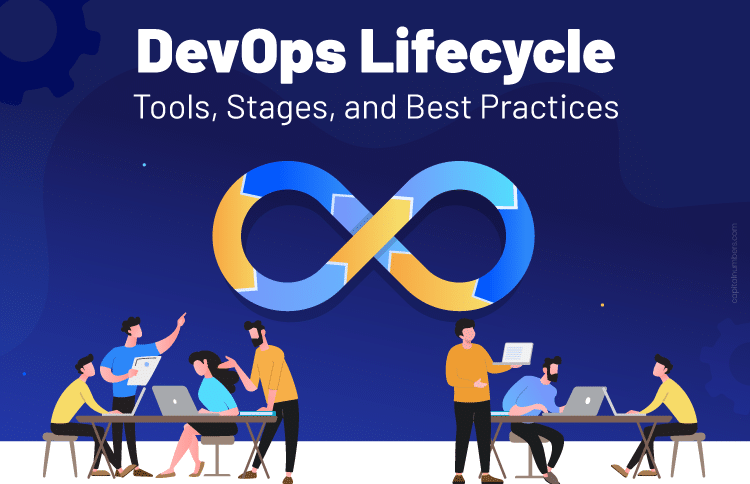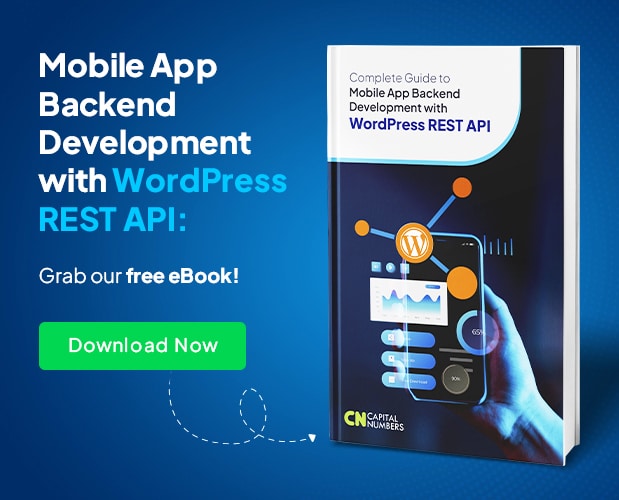PHP vs Node.js: Which is Better for Web Development in 2025?
Table of Contents
Choosing the right technology for your web development project can be tricky, especially with two strong contenders like PHP and Node.js. Both have stood the test of time, powering millions of websites and applications. But as we move into 2025, the tech landscape continues to evolve — with businesses weighing factors like performance, scalability, and development resources.
So, how do you decide between the reliability and maturity of PHP and the real-time, event-driven architecture of Node.js? In this blog, we’ll break down their key differences, explore typical use cases, and help you figure out which backend technology aligns better with your project goals.
Whether you’re exploring tech stacks for your startup, looking to scale an existing application, or planning to build a team with PHP or hire Node.js developers for long-term growth, this comparison will help you make a more informed decision.
What is PHP?
PHP (Hypertext Processor) is a general-purpose programming language to build websites and web applications. It runs on the server, processing data, generating dynamic content, and interacting with databases. PHP is simple, flexible, and widely used by developers to create everything from blogs to complex e-commerce websites. Some of the biggest websites, like Wikipedia, Facebook, and Etsy, rely on PHP to power their content and services.
Key Features of PHP
- Fast and Lightweight
PHP generates web pages quickly. It can also process requests and load pages faster than some other server-side languages, making it a good choice for websites that need to handle a large number of users. - Built-In Functions
PHP comes with many built-in functions that simplify tasks like string manipulation, file handling, and working with databases. This saves developers time since they don’t have to build everything from scratch. - Great for Handling Forms
PHP is commonly used for form handling on websites, whether it’s for collecting user information, processing payments, or managing login systems. It simplifies storing and retrieving data in databases, making it ideal for form-based applications. - Versatile and Customizable
PHP works well with many different types of databases, most commonly MySQL. It allows developers to customize websites and applications, giving them the flexibility to build about anything. Integration with HTML and Other Technologies PHP can be embedded directly into HTML code, making it easy to generate dynamic content. It also integrates well with other technologies, such as JavaScript, CSS, and APIs, helping create full-fledged web applications.
Best PHP Frameworks in 2025
- Laravel
Laravel is known for its clean, elegant syntax and is widely used for building modern web applications. Its features, such as built-in authentication, routing, and caching, make development faster and more secure. - Symfony
Symfony is a great choice for larger, more complex projects. It’s flexible and modular, so developers can use only the needed parts. This makes it perfect for enterprise-level applications that require scalability and high performance. - CodeIgniter
If you’re looking for a lightweight and fast PHP framework, CodeIgniter is an excellent option. It’s simple to set up and perfect for smaller projects or developers who need something quick without all the overhead. - Yii
Yii is a high-performance framework that is great for building large-scale applications. It’s fast and includes built-in tools to speed up development, making it a good choice for websites that need to handle high traffic. - CakePHP
CakePHP is a flexible and easy-to-use framework. It’s great for rapid application development (RAD) and helps developers build applications quickly without much configuration. It also follows best practices for security, making it a solid choice for many types of projects.
You May Also Read: Simplifying Cloud Web Development with Serverless PHP
Limitations of PHP
- Not Ideal for Real-Time Applications
PHP isn’t the best for real-time applications like chat rooms or live notifications. Since PHP works synchronously, it’s harder to manage constant, real-time updates efficiently. - Challenges with Handling High Traffic
While PHP can handle decent traffic, it can face performance issues when too many users interact with a site at once. Large-scale applications or high-traffic websites may need extra optimizations to ensure PHP performs well. - Security Vulnerabilities
PHP applications can be prone to security issues like SQL injections or cross-site scripting (XSS) if not properly secured. It’s crucial for developers to follow good practices, like using prepared statements to secure PHP applications. - Inconsistent Syntax in Older Code
Older PHP code may not follow modern best practices, making it harder to maintain. This is why newer frameworks like Laravel and Symfony are recommended, as they enforce cleaner coding standards. - Not Ideal for CPU-Intensive Tasks
PHP is great for managing web pages and handling requests but isn’t the best for performing heavy computations or CPU-intensive operations. For such tasks, you may want to use other programming languages alongside PHP.
What is Node.js?
Node.js is an open-source JavaScript runtime that lets developers run code on the server side. It uses Chrome’s V8 engine and works in a way that can handle many tasks at once, making it fast and efficient. This event-driven model allows Node.js to run without slowing down. It’s popular because developers can use JavaScript for both the front-end (in the browser) and back-end (on the server), which makes building full web applications easier. Node.js is used for enterprise application development due to its speed, scalability, and ability to handle high traffic and real-time data, with industry leaders like Netflix, LinkedIn, and Uber relying on it.
Key Features of Node.js
- Fast Execution with V8 Engine
Built on Google’s V8 engine, Node.js compiles JavaScript directly into machine code, offering excellent performance. This speed makes Node.js a popular choice for building fast, high-performance applications. - Real-Time Data Handling
One can use Node.js for building real-time applications. Its ability to process many requests at once, without blocking, makes it perfect for applications like online games, messaging apps, or live streaming services, where updates need to be sent to users in real-time. - JavaScript for Full-Stack Development
One of Node.js’s biggest advantages is that developers can use JavaScript for client- and server-side development. This helps streamline the development process, as the same language is used across the entire application. - Rich Ecosystem with NPM
Node.js has a rich ecosystem due to NPM (Node Package Manager), which offers many libraries and tools. This allows developers to easily add functionalities to their applications, speeding up development time. - Cross-Platform
Node.js works across various platforms, including Windows, macOS, and Linux. This cross-platform compatibility allows developers to work in different environments and deploy their applications on multiple systems with ease.
Best Node.js Frameworks in 2025
- Express.js
Express.js is one of the most popular Node.js frameworks, known for its simplicity and flexibility. It’s great for building APIs and web applications quickly, with support for routing, middleware, and HTTP utilities. - NestJS
NestJS is a TypeScript framework perfect for building scalable and maintainable enterprise applications. It follows a modular approach and is well-suited for building microservices, APIs, and GraphQL applications. - Koa.js
Koa.js, created by the team behind Express, is known for its minimalistic approach. It offers developers greater flexibility and control, making it an excellent choice for building custom APIs and highly performant web applications. - Sails.js
Sails.js is built for developing data-driven APIs and applications, using the MVC (Model-View-Controller) architecture. It’s great for building real-time apps and supports WebSockets out of the box. - Hapi.js
Hapi.js is a powerful framework for building robust and scalable applications. It’s designed to be highly customizable, making it suitable for building APIs, services, and real-time applications.
Limitations of Node.js
- Single-Threaded Nature
Although Node.js is great for handling I/O-heavy tasks, it can struggle with CPU-intensive operations like heavy data processing or complex calculations. Since Node.js runs on a single thread, these tasks can block the event loop, slowing down the entire application. - Callback Hell
Node.js uses callbacks to handle asynchronous operations. This can lead to nested callbacks, also known as “callback hell,” which can make the code harder to maintain. However, newer features like async/await can mitigate this issue. - Lack of Built-in Tools
Node.js is a minimalistic framework, which means it doesn’t provide many built-in tools for handling things like authentication, data validation, or database management. Developers often need to rely on third-party libraries, which can increase complexity. - Relatively New Ecosystem
While Node.js has a vast ecosystem, some developers may find that certain tools or libraries are less mature compared to those in other programming languages. This means careful consideration is needed before choosing libraries for large-scale or complex applications.
PHP vs Node.js for Web Development: A Detailed Comparison

If you are wondering which is better for web development, PHP or Node.js, and are finding it difficult to come to a conclusion, go through this detailed comparison. We’ll compare both technologies across several key parameters to guide you toward the right choice.
1. Coding
- PHP
Here’s how you can create a basic web server that displays “Hello, World!” in PHP:<?php echo "Hello, World!"; ?>This is simple and easy to set up, making it ideal for small projects. However, when working on larger projects, PHP requires a good understanding of concepts like database interactions, LAMP stack (Linux, Apache HTTP Server, MySQL, and PHP) configuration, and managing state across requests, which can increase complexity.
- Node.js
In Node.js, creating a basic web server to display “Hello, World!” would look like this:const http = require('http'); const server = http.createServer((req, res) => { res.writeHead(200, {'Content-Type': 'text/plain'}); res.end('Hello, World!'); }); server.listen(3000, () => { console.log('Server running at http://localhost:3000'); });At first, Node.js might seem to need more lines of code than PHP to do the same tasks. However, since everything is built with JavaScript, you only need to focus on one language, making it easier to work without switching between different syntaxes.
- Winner: Node.js
While PHP may be faster for small scripts, Node.js will eventually become more efficient and easier to manage for larger applications.
2. Performance
- PHP
PHP processes requests one at a time, which means it handles one task before moving on to the next. While this works well for smaller applications, it can slow down when dealing with multiple requests at the same time. For instance, when connecting to a database in PHP, the request must be completed before the next one can begin:<?php $conn = new mysqli("localhost", "user", "password", "database"); if ($conn->connect_error) { die("Connection failed: " . $conn->connect_error); } echo "Connected successfully"; ?>For larger, more complex applications, PHP can struggle to maintain performance under heavy traffic. However, linking PHP with HHVM (HipHop Virtual Machine) can significantly boost its performance.
- Node.js
Node.js is designed for high performance. Its non-blocking, event-driven architecture allows it to handle multiple tasks at once without slowing down. This makes it highly efficient for applications that need to process many requests simultaneously. Here’s how Node.js handles multiple requests:const http = require('http'); http.createServer((req, res) => { res.write('Hello World'); res.end(); }).listen(8080, () => { console.log("Server running on http://localhost:8080"); });Because Node.js handles tasks asynchronously, it can process many concurrent requests without waiting for each one to finish. This makes it useful for various applications, such as chat apps, live data streaming, and multiplayer games.
- Winner: Node.js
If you compare Node.js vs PHP performance, both are strong contenders. However, if performance is your top priority, Node.js would be the better choice.
3. Functionality
- PHP
PHP is mainly used for server-side scripting in web development. It’s popular for building dynamic websites and content management systems (CMS) like WordPress, Drupal, and Magento. PHP is great for handling content updates and working with databases to deliver dynamic pages. - Node.js
Node.js is ideal for applications that require high performance and scalability. It’s commonly used for building modular systems, microservices integration, and services that handle real-time data. With its non-blocking architecture, Node.js is well-suited for creating fast, scalable applications that grow with demand. - Winner: Tie
Both are great choices, but Node.js gets an extra advantage with the powerful NPM, which adds more functionality.
4. Ecosystem
- PHP
PHP has a large ecosystem, with frameworks like Laravel and Symfony that make development easier by providing tools for routing, authentication, and database management. It’s also widely used in WordPress, which relies on PHP to power dynamic websites and content management.// Authentication in Laravel Auth::login($user); - Node.js
Node.js has a rich ecosystem powered by NPM (Node Package Manager), offering millions of packages for developers. Libraries like Express.js help build APIs, while Socket.io is great for real-time communication and building scalable applications.const socket = require('socket.io'); const io = socket(server); io.on('connection', (socket) => { console.log('A user connected'); socket.emit('message', 'Hello, client!'); }); - Winner: Tie
Both PHP and Node.js have strong ecosystems. Node.js offers more flexibility with its wide range of tools through NPM, while PHP excels for content-based sites, especially with WordPress.
5. Hosting
- PHP
PHP is supported by almost all hosting providers, including shared hosting, VPS, and dedicated servers. Most of these hosting services offer one-click installations for PHP-based platforms like WordPress. - Node.js
Node.js hosting requires a more complex setup. It is usually hosted on cloud platforms like AWS, Google Cloud, or Heroku, and often requires containerized deployments or a dedicated server. - Winner: PHP
PHP remains one of the most affordable and widely supported hosting options, making it ideal for small to medium-sized projects – particularly on shared or budget-friendly hosting plans.
6. Concurrency
- PHP
PHP processes one request at a time, meaning it handles each request sequentially. This can cause delays when there are many requests, as each one must be completed before the next starts. This is fine for smaller applications but may slow down with high traffic or real-time data. - Node.js
Node.js uses a non-blocking architecture, allowing it to handle multiple requests at once. This makes it more efficient for real-time apps and sites with lots of users, as it doesn’t have to wait for one request to finish before handling the next. - Winner: Node.js
Node.js handles multiple requests more efficiently, while PHP can slow down with high concurrency.
7. Runtime Environments
- PHP
PHP runs on traditional web servers like Apache and Nginx. It uses the PHP interpreter to execute code on the server. - Node.js
Node.js runs its own runtime environment, powered by the V8 JavaScript engine. It allows for asynchronous I/O operations and supports JavaScript for both front-end and back-end development. - Winner: Node.js
Node.js provides a more modern and flexible runtime environment and is perfect for microservices and scalable apps.
8. Database
- PHP
PHP works well with relational databases like MySQL and PostgreSQL, which are commonly used for structured data storage. Laravel simplifies database interactions with its Eloquent ORM, making it easier to work with databases and manage relationships between tables.// Using Eloquent ORM in Laravel $user = User::find(1); - Node.js
Node.js can handle both relational and NoSQL databases. It is often used with MongoDB, a popular NoSQL database that stores data in a flexible, document-based format. This gives developers more flexibility in managing unstructured or semi-structured data.// Node.js with MongoDB example const mongoose = require('mongoose'); mongoose.connect('mongodb://localhost/mydb'); - Winner: Tie
Both PHP and Node.js are effective with databases.
9. Modules
- PHP
PHP offers a wide range of built-in modules and extensions, making it easy to add functionality like image processing, email handling, and more. It also supports common design patterns in PHP, such as MVC and Factory, which help organize code and improve maintainability. - Node.js
Node.js has a vast collection of modules available through npm (Node Package Manager). These modules allow you to easily integrate APIs, handle real-time data, and manage other tasks, giving developers a lot of flexibility to customize their applications. - Winner: Tie
Both PHP and Node.js offer powerful modules, but Node.js provides more flexibility through npm, giving developers access to a wider range of tools.
10. Security
- PHP
PHP has some security vulnerabilities, such as SQL injections, XSS (Cross-Site Scripting), and CSRF (Cross-Site Request Forgery). These vulnerabilities can pose risks if not handled properly. However, modern frameworks like Laravel come with built-in security features that help protect against these issues. For instance, Laravel provides input sanitization and CSRF protection to ensure safer interactions with the website.// CSRF protection in Laravel {{ csrf_field() }}Despite these built-in features, developers must stay vigilant and follow best practices to avoid PHP vulnerabilities, especially when working with user inputs and data.
- Node.js
Node.js is generally secure, but it requires careful management of third-party libraries and dependencies. Since Node.js relies heavily on NPM for packages, it’s important to regularly audit dependencies using tools like NPM audit to ensure there are no security flaws. Developers must also be cautious when using external libraries and always keep them updated. - Winner: Tie
Both PHP and Node.js require strong security practices.
PHP vs Node.js: When to Choose What?
Choosing between Node.js and PHP depends on the type of project you’re working on. Each technology has its strengths and is better suited for different use cases. So, before you hire PHP developers or Node.js experts for your next project, you need to carefully consider the specific needs of your application. Here’s a guide to help you decide which one to use when.
PHP Use Cases
- Content Management Systems (CMS): PHP is perfect for building CMS platforms like WordPress, Joomla, and other systems that handle dynamic content. It works seamlessly with relational databases like MySQL, making it ideal for managing web pages, media assets, and more.
- E-commerce Websites: PHP is used by many popular e-commerce platforms, such as Magento, PrestaShop, and OpenCart. It offers numerous pre-built plugins that automate tasks like payment processing, inventory management, and order tracking.
- Enterprise Applications: PHP frameworks like Laravel and Symfony are commonly used for larger, more complex applications. These frameworks support authentication systems, data processing, and business logic, making PHP a reliable choice for enterprise-level applications.
- Small to Medium Projects: PHP is a great option for small to medium-sized projects, especially MVPs. Its support for shared hosting, combined with its mature ecosystem, helps reduce development costs while ensuring high-quality results.
- Educational Platforms: PHP is ideal for building platforms like Moodle, which are used for managing online courses and interactive content.
You May Also Read: Ultimate Guide to Developing an eCommerce Website Using PHP
When to Choose PHP:
- When you need a reliable solution for small to medium-sized businesses.
- If your project requires both CMS functionality and relational databases.
- When you prefer a mature, well-documented framework to build upon.
Node.js Use Cases
- Real-Time Applications: Node.js excels in handling real-time apps like chat applications, collaboration tools, and multiplayer games. Its non-blocking I/O model enables it to manage multiple requests at once without slowing down.
- Streaming Applications: With its event-driven design, Node.js is highly efficient for video and audio streaming applications. It handles large streams of data smoothly and delivers content in real-time.
- RESTful APIs and GraphQL: Node.js is popular for developing RESTful APIs and GraphQL servers, particularly in a microservices environment. It offers a fast runtime and lightweight architecture that is perfect for API-based applications.
- IoT (Internet of Things): Node.js is great for IoT applications, handling multiple device connections and asynchronous data. It works well for smart home systems and industrial IoT applications.
- Serverless Architecture: Node.js integrates seamlessly with platforms like AWS Lambda, allowing developers to build scalable applications without worrying about server infrastructure.
When to Choose Node.js:
- When your project requires real-time features or processes significant amounts of data.
- For building Single Page Applications (SPAs) or mobile APIs.
- If scalability, concurrency management, and optimal performance are key factors for your application.
You May Also Read: Migrating from LAMP to MERN: Why It’s Worth the Switch
Frequently Asked Questions
1. Will Node.js replace PHP?
No, Node.js won’t replace PHP. Both have different uses and strengths. PHP is still great for content-based websites, while Node.js is better for real-time apps and scalability.
2. Can PHP handle high-traffic websites?
Yes, PHP can handle high traffic with the right optimizations, like caching and using frameworks. It may need extra resources for very large-scale sites but is still capable of handling traffic efficiently.
3. When to choose PHP over Node.js for a project?
Choose PHP for content-heavy websites, CMS platforms, or smaller projects. It works well with relational databases and is easier to set up for traditional websites.
4. What are the security considerations when using PHP or Node.js?
Both need good security practices. In PHP, watch out for SQL injections and XSS. In Node.js, keep third-party libraries updated and check for vulnerabilities with NPM audit.
5. Can PHP and Node.js be used together in the same project?
Yes, PHP and Node.js can be used together. PHP can handle the website’s content, and Node.js can manage real-time features or APIs, with both communicating through APIs.
Final Words
Choosing between PHP and Node.js depends on the specific needs of your project. PHP remains a strong choice for content-driven websites and CMS platforms, while Node.js shines when it comes to building scalable, real-time applications. As backend frameworks continue to evolve in 2025, both technologies have their place in modern web development. Consider your project’s requirements and the strengths of each to make the right choice. Whether you go with PHP or Node.js, both offer powerful tools to build robust and efficient web applications. So, choose the technology that aligns with your project goals, team skills, and future scalability needs, and set your project up for long-term success.















